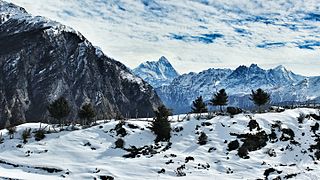Related Research Articles

Kumaon is a revenue and administrative division in the Indian State of Uttarakhand. It spans over the eastern half of the state and is bounded on the north by Tibet, on the east by Nepal, on the south by the state of Uttar Pradesh, and on the west by Garhwal. Kumaon comprises six districts of the state: Almora, Bageshwar, Champawat, Nainital, Pithoragarh and Udham Singh Nagar.

performance music The folk music of Uttarakhand refers to the traditional and contemporary songs of Kumaon and Garhwal regions in the foothills of Himalayas. This music has its root in nature and the hilly terrain of the region.

Uttarakhand, formerly known as Uttaranchal, is a state in northern India. It is often referred to as the "Devbhumi" due to its religious significance and numerous Hindu temples and pilgrimage centres found throughout the state. Uttarakhand is known for the natural environment of the Himalayas, the Bhabar and the Terai regions. It borders the Tibet Autonomous Region of China to the north; the Sudurpashchim Province of Nepal to the east; the Indian states of Uttar Pradesh to the south and Himachal Pradesh to the west and north-west. The state is divided into two divisions, Garhwal and Kumaon, with a total of 13 districts. The winter capital, and largest city of the state is Dehradun, which is also a rail head. On 5 March 2020, Bhararisain, a town in the Gairsain Tehsil of the Chamoli district, was declared as the summer capital of Uttarakhand. The High Court of the state is located in Nainital, but is to be moved to Haldwani in future.

Kumaoni is an Indo-Aryan language spoken by over two million people of the Kumaon region of the state of Uttarakhand in northern India and parts of Doti region in Western Nepal. As per 1961 survey there were 1,030,254 Kumaoni speakers in India. The number of speakers increased to 2.2 million in 2011.

Garhwali is an Indo-Aryan language of the Central Pahari subgroup. It is primarily spoken by over 2.5 million Garhwali people in the Garhwal region of the northern Indian state of Uttarakhand in the Indian Himalayas.

The Reliques of Ancient English Poetry is a collection of ballads and popular songs collected by Bishop Thomas Percy and published in 1765.

Narendra Singh Negi, also referred as 'Garh Ratan' and 'Bob Dylan of the hills' is one of the most prominent folk singers, composer and a poet of the Garhwal and Uttarakhand who prominently sings in Garhwali language. Reportedly, he has sung more than 1000 songs. His unparalleled work in the field of folk music of Uttarakhand is an inspiration for all the upcoming singers of Uttarakhand.

The Garhwali people are an Indian ethnolinguistic group native to the Garhwal, in the Indian state of Uttarakhand, who speak Garhwali, an Indo-Aryan language.

Anoop Chandola, author of 20 books, 4 coauthored is an American linguist-anthropologist, originally from Pauri, where he was raised in a priestly Brahmin family. Though his father and uncles broke their ancestral polygamous tradition he suffered from the after-effects of polygamy.

Garhwal Kingdom was an independent Himalayan kingdom in the current north-western Himalayan state of Uttarakhand, India, founded in 688 CE by Kanak Pal, the progenitor of the Panwar dynasty that ruled over the kingdom uninterrupted until 1803 CE.
The mashak is a type of bagpipe found in Northern India, Uttarakhand, Sudurpaschim Province of Nepal and parts of Pakistan and Afghanistan. The pipe was associated with weddings and festive occasions. In India it is historically found in Kumaon and Garhwal in Uttarakhand, Rajasthan and Uttar Pradesh. This bagpipe uses single reeds, and can be played either as a drone or as a melody instrument.

Kumaon Kingdom was an independent Himalayan kingdom in Kumaon, a region located in the eastern part of the present-day Uttarakhand state of India. It was established around 7th century and remained an independent and sovereign kingdom until 1791.
Gairola is a clan of the Garhwali Sarola Brahmins and is also a toponymic surname from Gairoli, a village in the Chamoli district of Uttarakhand, India. In an earlier time period, Gairolas were believed to be astrologers and Raj-Purohits. Notable people with this surname include:
Jeet Singh Negi was a music composer, singer, lyricist, writer and director from the Garhwal region of Uttarakhand, India. He is considered to be the father of modern Garhwali folk music.
Leeladhar Jagudi is an Indian teacher, journalist and poet of Hindi literature. He is the author of several poetry anthologies including Natak Jari Hai and Shankha Mukhi Shikharon Par and is a recipient of the Sahitya Akademi Award, for his 1997 anthology, Anubhav Ke Aakash Mein Chand. The Government of India awarded him the fourth highest civilian honour of the Padma Shri, in 2004, for his contributions to Hindi literature.
Abodh Bandhu Bahuguna was a Hindi and Garhwali writer and poet. He is known for his poems, epics, plays, folk-literature, and essays.
Chander Singh Rahi was a prominent folk singer, balladeer, musician, poet, storyteller, and cultural conservator from Uttarakhand, India.
Mukandi Lal was an Indian advocate, judge, freedom fighter, politician, writer and art critic from Garhwal, in the Indian Himalayas.
Shiv Prasad Dabral, known by his pen name Charan, was an Indian historian, geographer, academic and writer from Uttarakhand. He is also known as 'Encyclopedia of Uttarakhand'. He started writing from 1931 onwards. He is the author of the monumental history of Uttarakhand in 18 volumes, 2 collections of poetry, 9 plays, and several edited volumes in Hindi and Garhwali. His Uttarakhand ka Itihaas is widely used by scholars as reference work. He authored several books on the archeology and ecology of Uttarakhand. To his credit, Charan saved 22 rare books of Garhwali language from extinction by republishing them at his own press. He also rediscovered a rare poetry manuscript of Mola Ram.
References
- ↑ Fiol, Stefan. Recasting Folk in the Himalayas: Indian Music, Media, and Social Mobility. Unervisty of Illinois Press.